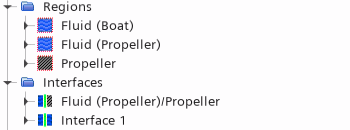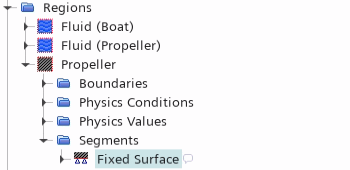Loading the Initial Simulation
As the focus of this tutorial is defining the motion of the system, you are provided with a starting simulation that includes the required regions, boundaries, interfaces, and physics continua. Load the initial simulation in Simcenter STAR-CCM+ and review the predefined settings.
To load the initial simulation:
- Launch Simcenter STAR-CCM+.
- Select
- In the Load a File dialog, click Browse...
- In the Open dialog, navigate to the solidStress folder of the downloaded tutorial files.
- Select boatWithPropeller_start.sim and click Open.
- In the Load a File dialog, click OK.
- Save the simulation as boatWithPropeller.sim.
-
Review the predefined continua, regions, and interfaces by expanding the relevant nodes:
- Regions and Interfaces
- The simulation requires three regions—one
for the fluid around the boat and its components, one for the fluid
around the propeller, and one for the solid propeller. As the boat
is modeled as a 6-DOF rigid body, rather than a deformable solid,
you do not require a solid region for the boat—only for the
propeller, which is deformable. The regions are connected through
the following interfaces:
- fluid-structure interface between the solid propeller and the fluid around the propeller
- fluid-fluid interface between the main fluid region and the fluid around the propeller

- Physics Continua
- The starting simulation contains two physics continua—one for the fluid regions, and one for the solid region:
- For the fluid continuum, you account for the
presence of both air and water using the Volume
of Fluid (VOF) model. You also account for
the generation of waves at the air-water free surface using
the VOF Waves model. The model
selection also accounts for the effect of turbulence and
gravity. Relevant initial conditions and boundary conditions
are fully set up.

- For the solid continuum, you model the propeller
as a deformable linear elastic solid using the
Solid Stress model. Data is
exchanged (fluid loads and solid displacements) at the
interface between the propeller and the surrounding fluid.
To improve convergence, you use the Rayleigh
Damping model, with stiffness proportional
damping.

For the solid boundary conditions, a surface constraint fixes the propeller hub to the boat engine:
- For the fluid continuum, you account for the
presence of both air and water using the Volume
of Fluid (VOF) model. You also account for
the generation of waves at the air-water free surface using
the VOF Waves model. The model
selection also accounts for the effect of turbulence and
gravity. Relevant initial conditions and boundary conditions
are fully set up.
- Save the simulation.